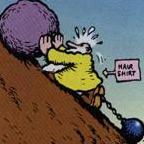Drongo
Posts: 2205
Joined: 7/12/2002
From: Melb. Oztralia
Status: offline

|
[QUOTE]My understanding is that the only change was that ships were limited to firing no more than twice for every combat round that has happened so far. So if a ship for some reason does not fire in round 1, it is limited to firing no more than 4 times in round 2. [/QUOTE]
I think I have just been on the receiving end in a surface engagement of the 1.20 change that Joel referred to above.
Situation : Scen 17, 7/42, player(USN) versus AI. I had several TF's of unescorted (naturally) transports unloading urgently needed troops/supplies at PM. A large IJN CA force was spotted making a night run to hit the port that turn. A surface combat TF was created from what was available. It consisted of 2 USN CA's (with SC radar) and a DD. "Ching" Lee was placed in charge. A night defeat was acceptable if it kept the IJN away from the transports.
The IJN threat duly arrived that night and materialised in the form of 5 CA's, 1 CL and 2 DD's:eek: Neither side gained any initial tactical advantage. The first round involved an ineffective exchange between an IJN CA and the USN CA Portland at 8000 yards. The second round continued at the same range and began, as before, with another ineffective exchange between the same 2 ships. Another IJN CA (Furutaka) then decided to join in and delivered the most devastating round of fire I have ever seen in UV. I do not know how many salvos it fired but the Portland received 11 8" hits before it could blink, let alone attempt to return fire. That one continuous "burst" brought the second round and the Portland's service career to an end (it sank immeadiately). The other USN ships were sent to the bottom shortly after by the relatively conventional tactic of being engaged by large no's of unfriendly ships. For their troubles, the IJN received a single 8" hit on one of their CA's (unfortunately not the Fur-"uber"-taka).
From Joel's quote, I assume the following happened. As the Furutaka had not engaged in the first round, it had a max no. of shots of 4 in the second round. If the Portland had fired twice (probably) in the second round in it's exchange with the other IJN CA, it would not be able to conduct any further firing for the rest of the round, even though it was being fired at. The Furutaka probably got off its max shots (4) and it probably just got lucky. Does this seem correct to anyone else?
I was happy to see the changes to surface combat that were brought in with 1.20 as IMO I thought the results from engagements were uniformly far too bloody to both sides compared to the historical battles. I have no problems with being annihilated by a superior foe who suffers little or no loss:mad: if the circumstances warrant it but I am curious about the rationale of allowing a ship (whether it be mine or the enemy's) to potentially "carry over" shots from previous rounds. If a ship has not fired in a previous round, so what? The rules had explained that adequately in terms of inexperience, poor visibility, etc. If a ship finds itself able to engage the next round, why would it not fire only twice (max) like other vessels that are already engaged (if that is what is actually happening now under 1.20).
While on the subject, does any one know whether specific damage (ie gun, electrical, radar, *massive explosion*, etc) received by a vessel during a combat round has any effect on the effectiveness of its subsequent salvos for that round or even later ones? I have seen many times where vessels receive heavy damage from an opening salvo in a round and yet seem to fight on with what appears to be full effectiveness until it "suddenly" sinks at the end of a combat round (I'm not including any "simultaneous" salvos from the damaged vessel as they would be unimpaired). Historical accounts of the battles off Guadalcanal show several times how ships were knocked out of the battle (both temporarily and permanantly), without being sunk, when they received a debilitating hit (ie power loss, fire control wrecked, torpedo "shock" etc.). This may be already factored in but I have never noticed it. It would certainly make any IJN admirals day (night) if the USN BB South Dakota were to be sailing blind and helpless for a round or two of target practice due to loss of electricals/radar as it was in the Second Naval Battle for Guadalcanal (from memory).
[QUOTE]One thing I have not seen as a frequent Japanese player is the tactic used in a few battles of firing the torpedoes first. [/QUOTE]
I totally agree. Considering the near total emphasis historically of the IJN light surface forces on delivering night torpedo attacks, I was surprised at the fact that this was not incorporated into the battles. The IJN certainly have the night experience advantage early as well as the superior Long Lance (+ reloads) present in UV but I don't see any evidence of their doctrine in battles. From what I've seen, I would assume (maybe wrongly) that USN DD's would fire torpedos as often as their IJN counterparts if their night experience was the same. Maybe the tactic of Crossing the "T" could be replaced by Glorious Charge of the Long Lances ;) and allow a % of IJN DD's and CL's to release torpedos in a free initial round prior to the guns opening up on both sides. Whatever was done, it would be nice to get a feel of the gun v torp doctrines and allow greater involvement of the DD's from both sides (USN DD's were showing how it was done in '43). Given how a combination of good radar/experience will start tipping the balance to the USN as games go on, I think the IJN should have a clearer chance in early battles to try to give their doctrine a go (or to make hay while the sun (moon) shines!). Excuse the puns but its late at night over here.
_____________________________
Have no fear,
drink more beer.
|
 Printable Version
Printable Version














 New Messages
New Messages No New Messages
No New Messages Hot Topic w/ New Messages
Hot Topic w/ New Messages Hot Topic w/o New Messages
Hot Topic w/o New Messages Locked w/ New Messages
Locked w/ New Messages Locked w/o New Messages
Locked w/o New Messages Post New Thread
Post New Thread